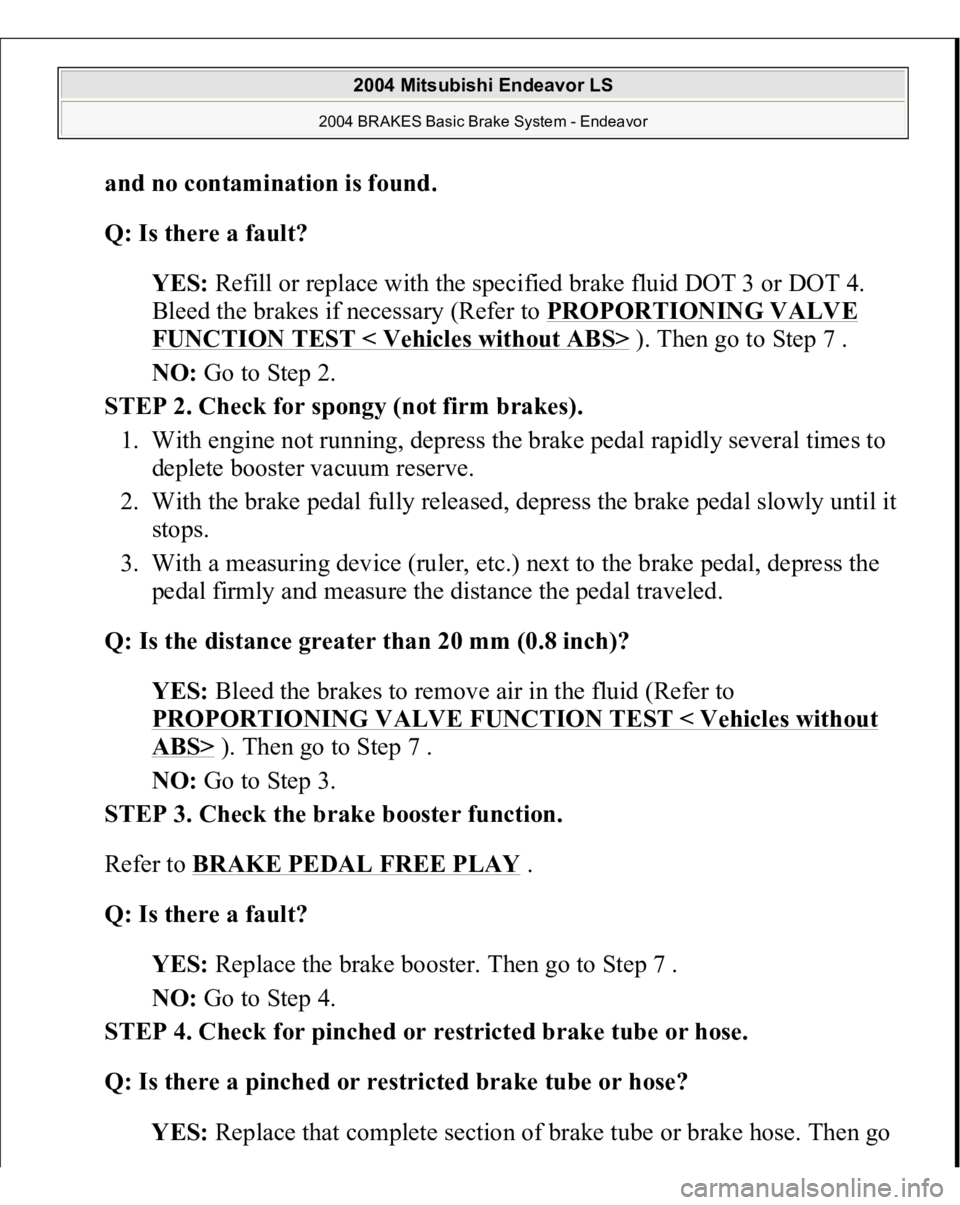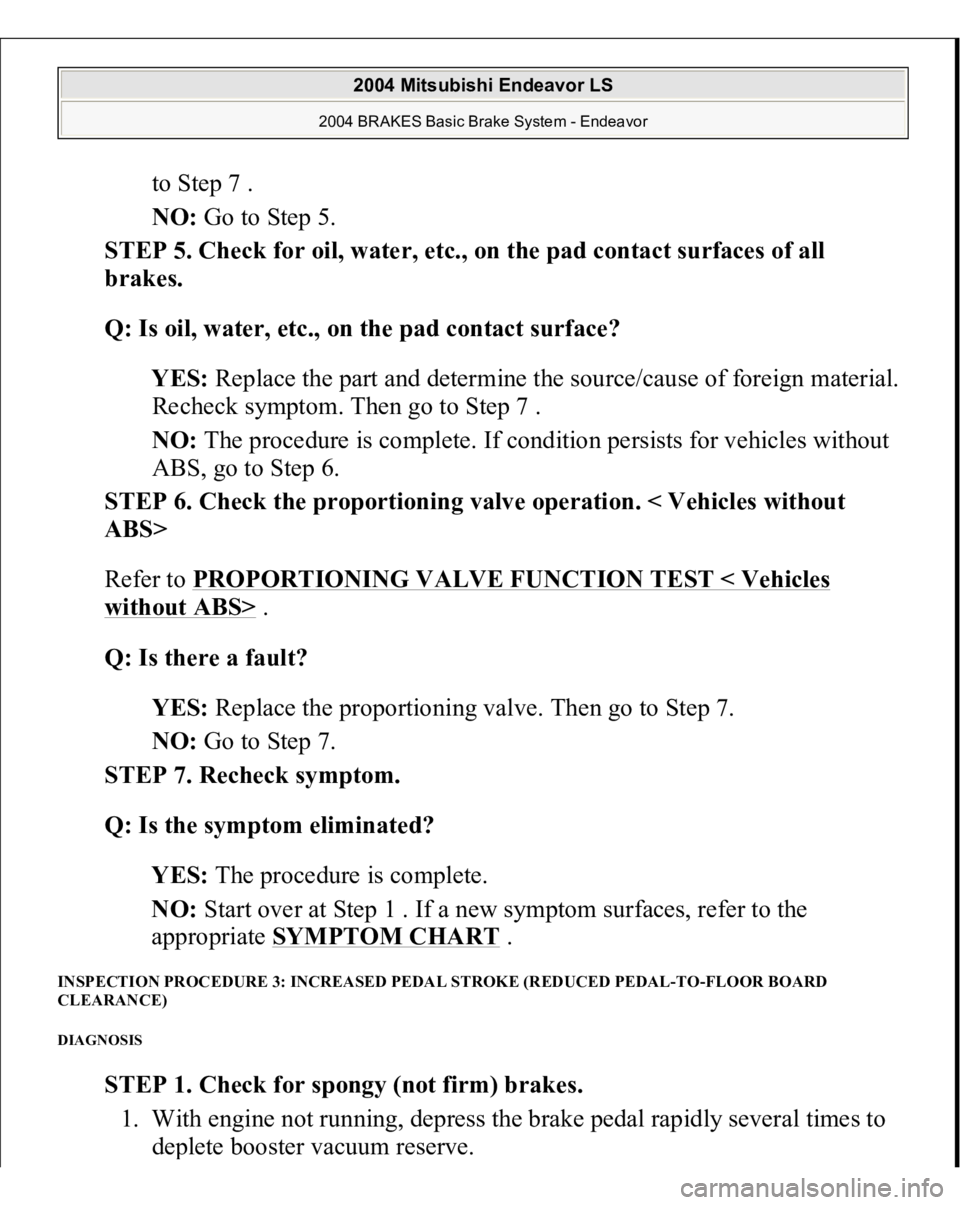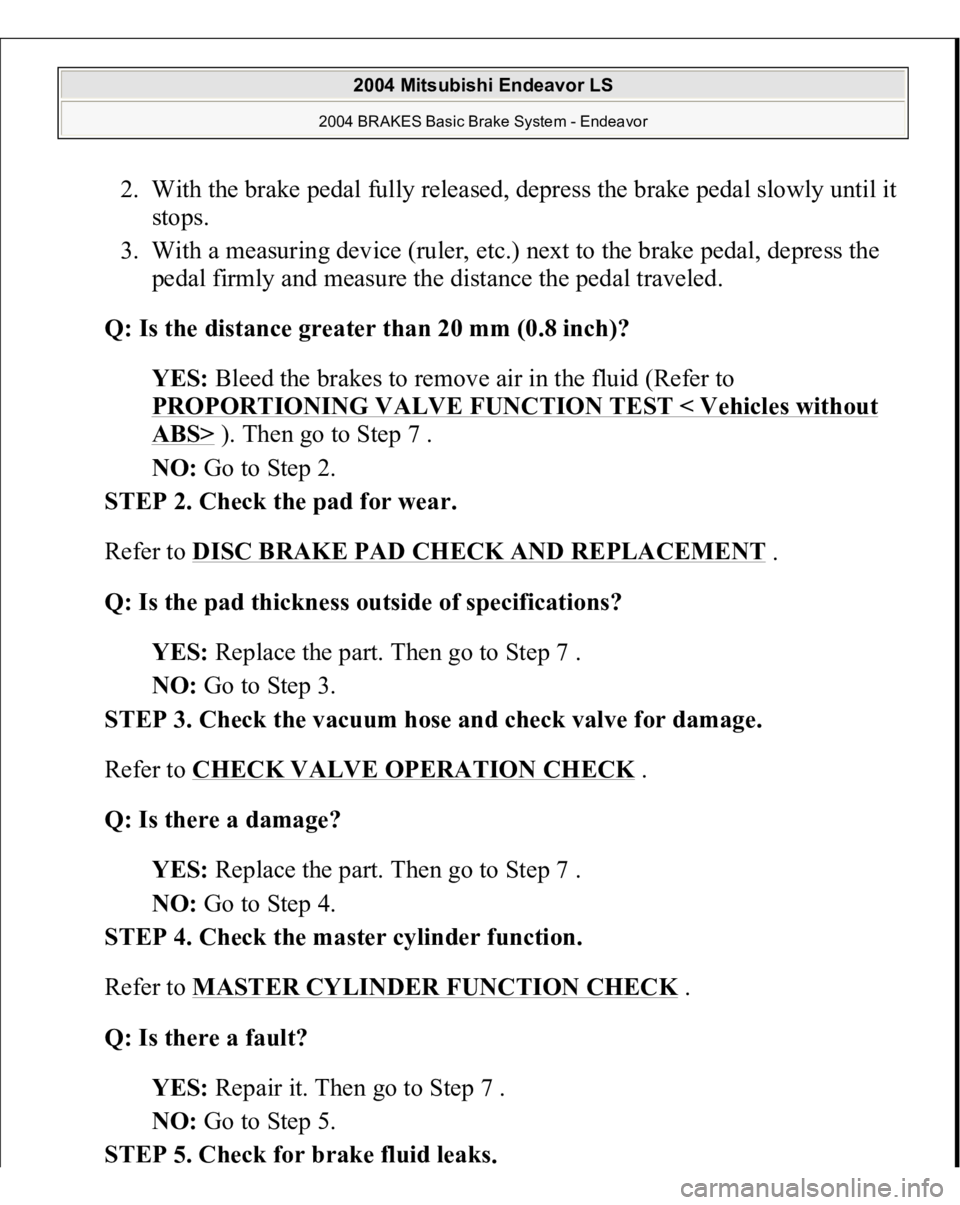Page 673 of 3870

2004 DRIVELINE/AXLES
Front Axle - Endeavor
GENERAL DESCRIPTION The front axle consists of front hubs, knuckles, wheel bearings and drive shafts, and
has the following features:
The wheel bearing incorporates a unit ball bearing (double-row angular contact
ball bearing) for reduced friction. The front wheel hub assembly combines the hub, wheel bearing, housing, and
oil seal in a single unit for fewer parts, better durability, improved assembly
precision, and better structural organization. The driveshaft incorporates BJ-PTJ type constant velocity joints< FWD>, BJ-
DOJ < AWD-LH>and BJ-TJ< AWD-RH> with high transmission efficiency
for low vibration and noise. Due to the use of the inner shaft and bracket assembly, the right and left drive
shafts are approximately the same in length. This reduces noise, vibration and
torque steer.< FWD> ABS rotor for detecting the wheel speeds is press-fitted to the rear hub in
vehicles with ABS.
CONSTRUCTION DIAGRAM NOTE:
PTJ: Pillow Tripod Joint BJ: Birfield Joint DOJ: Double Offset Joint TJ: Tripod Joint
2004 Mitsubishi Endeavor LS
2004 DRIVELINE/AXLES Front Axle - Endeavor
2004 Mitsubishi Endeavor LS
2004 DRIVELINE/AXLES Front Axle - Endeavor
Page 701 of 3870

2004 BRAKES
Basic Brake System - Endeavor
GENERAL DESCRIPTION The brake system has been designed to give greater reliability and durability and to
provide excellent braking performance. FEATURES IMPROVED BRAKING PERFORMANCE 1. A 9+10 inch tandem brake booster has been adopted to provide sufficient
braking force in sudden braking range.
2. Front ventilated disc brakes have been adopted to provide stabled braking force
and improved braking feel.
3. Rear solid disc brakes have been adopted. IMPROVED STABILITY 1. A 4-wheel anti-lock braking system (4ABS) has been adopted to prevent
slipping caused by the vehicle wheels locking up, in order to maintain a stable
vehicle posture and steering performance.
2. An electronic brake-force distribution (EBD) makes it possible to maintain the
maximum amount of braking force even when the vehicle's load is unevenly
distributed. < Vehicles with ABS>
3. A rear wheel early lock-prevention proportioning valve has been adopted. <
Vehicles without ABS>
4. Front- and rear-wheel X-type brake line layout has been adopted.
5. Ventilated discs have been adopted for front brakes in order to improve anti-
fading performance. IMPROVED SERVICEABILITY 1. A diagnosis function has been adopted for the ABS system in order to make
inspection easier.
2. An outer disc separated hub and rotor has been adopted to make removal and
2004 Mitsubishi Endeavor LS
2004 BRAKES Basic Brake System - Endeavor
2004 Mitsubishi Endeavor LS
2004 BRAKES Basic Brake System - Endeavor
Page 702 of 3870
installation easier.
3. The master cylinder reservoir tank cap has been colored white to make
identification easier.
4. The ABS-ECU and hydraulic unit have been integrated to make them more
compact and light weight.
CONSTRUCTION DIAGRAM < VEHICLE WITH ABS>
Fig. 1: Identifying Vehicle With ABS Brake
Courtesy of MITSUBISHI MOTOR SALES OF AMERICA.
< VEHICLE WITHOUT ABS>
2004 Mitsubishi Endeavor LS
2004 BRAKES Basic Brake System - Endeavor
Page 703 of 3870
Fig. 2: Identifying Vehicle Without ABS Brake
Courtesy of MITSUBISHI MOTOR SALES OF AMERICA.
BASIC BRAKE SYSTEM DIAGNOSIS INTRODUCTION TO BASIC BRAKE SYSTEM DIAGNOSIS Hydraulic brakes are composed of the brake pedal, master cylinder, brake booster
and disc brakes. Malfunctions such as insufficient braking power or the generation
of noise may occur due to wear, damage or incorrect adjustment of these
components. BASIC BRAKE SYSTEM DIAGNOSTIC TROUBLESHOOTING STRATEGY Use these steps to plan your diagnostic strategy. If you follow them carefully, you
will be sure that you have exhausted most of the possible ways to find a basic brake
system fault.
1. Gather information from the customer.
2. Verify that the condition described by the customer exists.
3. Find the malfunction by following the symptom chart.
4. Verif
y malfunction is eliminated.
2004 Mitsubishi Endeavor LS
2004 BRAKES Basic Brake System - Endeavor
Page 706 of 3870

and no contamination is found
.
Q: Is there a fault?
YES: Refill or replace with the specified brake fluid DOT 3 or DOT 4.
Bleed the brakes if necessary (Refer to PROPORTIONING VALVE
FUNCTION TEST < Vehicles without ABS>
). Then go to Step 7 .
NO: Go to Step 2.
STEP 2. Check for spongy (not firm brakes).
1. With engine not running, depress the brake pedal rapidly several times to
deplete booster vacuum reserve.
2. With the brake pedal fully released, depress the brake pedal slowly until it
stops.
3. With a measuring device (ruler, etc.) next to the brake pedal, depress the
pedal firmly and measure the distance the pedal traveled.
Q: Is the distance greater than 20 mm (0.8 inch)?
YES: Bleed the brakes to remove air in the fluid (Refer to
PROPORTIONING VALVE FUNCTION TEST < Vehicles without
ABS>
). Then go to Step 7 .
NO: Go to Step 3.
STEP 3. Check the brake booster function.
Refer to BRAKE PEDAL FREE PLAY
.
Q: Is there a fault?
YES: Replace the brake booster. Then go to Step 7 .
NO: Go to Step 4.
STEP 4. Check for pinched or restricted brake tube or hose.
Q: Is there a pinched or restricted brake tube or hose?
YES: Replace that complete section of brake tube or brake hose. Then go
2004 Mitsubishi Endeavor LS
2004 BRAKES Basic Brake System - Endeavor
Page 707 of 3870

to Step 7 .
NO: Go to Step 5.
STEP 5. Check for oil, water, etc., on the pad contact surfaces of all
brakes.
Q: Is oil, water, etc., on the pad contact surface?
YES: Replace the part and determine the source/cause of foreign material.
Recheck symptom. Then go to Step 7 .
NO: The procedure is complete. If condition persists for vehicles without
ABS, go to Step 6.
STEP 6. Check the proportioning valve operation. < Vehicles without
ABS>
Refer to PROPORTIONING VALVE FUNCTION TEST < Vehicles
without ABS>
.
Q: Is there a fault?
YES: Replace the proportioning valve. Then go to Step 7.
NO: Go to Step 7.
STEP 7. Recheck symptom.
Q: Is the symptom eliminated?
YES: The procedure is complete.
NO: Start over at Step 1 . If a new symptom surfaces, refer to the
appropriate SYMPTOM CHART
.
INSPECTION PROCEDURE 3: INCREASED PEDAL STROKE (REDUCED PEDAL-TO-FLOOR BOARD
CLEARANCE) DIAGNOSIS
STEP 1. Check for spongy (not firm) brakes.
1. With engine not running, depress the brake pedal rapidly several times to
de
plete booster vacuum reserve.
2004 Mitsubishi Endeavor LS
2004 BRAKES Basic Brake System - Endeavor
Page 708 of 3870

2. With the brake pedal fully released, depress the brake pedal slowly until it
stops.
3. With a measuring device (ruler, etc.) next to the brake pedal, depress the
pedal firmly and measure the distance the pedal traveled.
Q: Is the distance greater than 20 mm (0.8 inch)?
YES: Bleed the brakes to remove air in the fluid (Refer to
PROPORTIONING VALVE FUNCTION TEST < Vehicles without
ABS>
). Then go to Step 7 .
NO: Go to Step 2.
STEP 2. Check the pad for wear.
Refer to DISC BRAKE PAD CHECK AND REPLACEMENT
.
Q: Is the pad thickness outside of specifications?
YES: Replace the part. Then go to Step 7 .
NO: Go to Step 3.
STEP 3. Check the vacuum hose and check valve for damage.
Refer to CHECK VALVE OPERATION CHECK
.
Q: Is there a damage?
YES: Replace the part. Then go to Step 7 .
NO: Go to Step 4.
STEP 4. Check the master cylinder function.
Refer to MASTER CYLINDER FUNCTION CHECK
.
Q: Is there a fault?
YES: Repair it. Then go to Step 7 .
NO: Go to Step 5.
STEP 5. Check for brake fluid leaks
.
2004 Mitsubishi Endeavor LS
2004 BRAKES Basic Brake System - Endeavor
Page 738 of 3870
Fig. 23: Vacuum Pump Specification
Courtesy of MITSUBISHI MOTOR SALES OF AMERICA.
PROPORTIONING VALVE FUNCTION TEST < Vehicles without ABS> 1. Connect two pressure gauges to the output port of the master cylinder and
output port of the proportioning valve.
CAUTION: The proportioning valves are installed independently
for the right and left brake lines. Always measure
each valve.
2004 Mitsubishi Endeavor LS
2004 BRAKES Basic Brake System - Endeavor